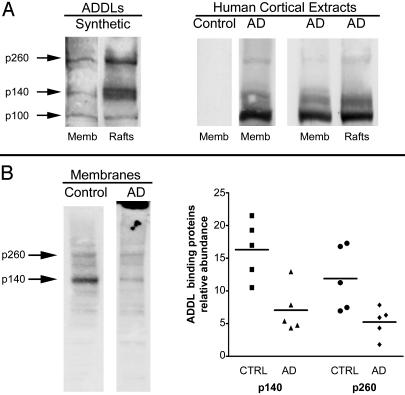Fig. 6.
Comparative ligand overlay assays using rat and human membrane proteins. (A Left) Synthetic ligands and rat membranes. Shown is an overlay assay with synthetic Aβ oligomers and rat brain total membranes or fractions enriched in rafts. Additional binding was evident at p100, a band not always detected; compare with Fig. 5A. Binding at p140 and p260 was enriched in rafts. (A Right) Human ligands and rat membranes. Shown is an overlay assay with soluble extracts from human brain (AD or controls) applied to rat brain membranes (total membranes or rafts). AD-soluble extracts showed prominent binding at p100, but binding at p140 and p260 binding was evident in total membranes and in rafts. No signal was found in extracts from control brains. (B Left) synthetic ligands and human membranes. Shown is an overlay assay using total membranes pelleted from human brain and 10 nM synthetic ADDLs. Comparison of control and AD subjects indicated fewer binding sites in AD (note fibrillar amyloid in AD membrane fraction; top of gel). (B Right) Densitometric quantitation of p140 and p260 substantiated fewer binding sites in AD brain.

